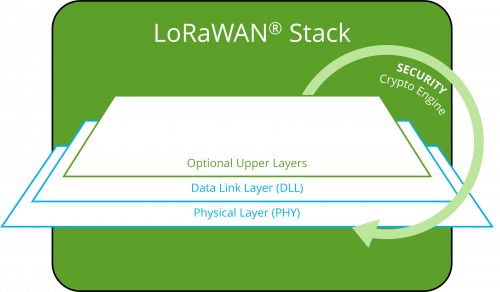You have already dealt with the topic of LoRaWAN®, but do not yet have a clear idea of whether the open-source components are sufficient for your needs? STACKFORCE's LoRaWAN® Protocol Stack is an advanced evolution of the open-source LoRaWAN® Stack. It is fundamentally designed for high-performance industrial use in complex environments with high security requirements and maximum performance. Likewise, the STACKFORCE Stack saves you valuable resources and allows you to schedule the deployment of the software in a plannable manner. Read more about the stack features, implemented standards and the advantages of the STACKFORCE Stack compared to the open-source variant in the article.
LoRaWAN® Stack Features
The LoRaWAN® Stack implements two layers:

With the LoRaWAN® Stack, a flexible API as well as interface for externalization of e.g. security functions, a well-designed Hardware Abstraction Layer (HAL) and a consistent look-and-feel of the API are delivered by default for the software library. In the modem application, all API functions are available via the supplied serial interface implementation, which supports UART, SPI and other ports and offers minimal overhead while providing 1:1 the API of the stack via a serial interface. For particularly sensitive applications, the modem application even offers the option of AES encrypted use of the serial interface.
Likewise, the integration of any type of fixed memory such as EEPROM, Flash or MRAM is supported. Flexible interfaces ensure easy adaptation and platform-specific optimization, e.g. for hardware-supported AES decryption/encryption or CRC-16. The LoRaWAN® Stack is delivered with bidirectional communication according to class A as standard, but class C (continuous reception) and class B (time slot-organized reception) can also be used. Thus, the direction of reception can be freely selected in a power-saving and application-dependent manner.
Which standards does the stack implement?
The LoRaWAN® Protocol Stack for end nodes is an implementation of the LoRaWAN® specification v1.0.4 and the associated LoRaWAN® regional parameters, which are designed for the operation of end nodes according to this standard. LoRaWAN® specifies the use of different frequency bands worldwide within the Regional Parameters with for example EU868, US915, AU915, AS923 and IN865. This means that a reliable standard can be used even across national borders.
Functionally, the stack can be delivered in a variant with Class B support. For Updates in the field there is the possibility to use the "Firmware Update Over The Air" (FUOTA) function. In addition, the LoRaWAN® Stack is well prepared for the operation of multi-stack environments from STACKFORCE and provides an easy-to-use unified multi-stack API for this purpose. Due to the well-designed hardware abstraction, a LoRa®-enabled radio chip is essentially the only hardware requirement to use the STACKFORCE LoRaWAN® Stack.
Advantages compared to the open-source stack
STACKFORCE's LoRaWAN® Stack has clear advantages over the open-source variant. It offers functionalities that are not included in the open-source stack, or only to a limited extent:
- For easy integration, the STACKFORCE LoRaWAN® Stack provides a Simple C library.
- The stack contains a management entity for structuring all stack parameters.
- The operation within a multi-stack is prepared. A simple switch to a dual stack with e.g. Wireless M-Bus, mioty® or Sigfox is thus possible. Even triple stacks with mioty® and Sigfox or with Wireless M-Bus and mioty® are no problem.
- The stack has an option to overcome duty cycle limitation (LBT-AFA). So, it is possible to use a larger bandwidth.
- The STACKFORE Stack has the industrial grade maturity. Accordingly, it is extensively tested and comes with warranty.
- With the STACKFORCE Stack we guarantee standard conformity. When porting the software to special customer hardware, we guarantee certification by LoRaWAN® test houses.
- For the LoRaWAN® Stack, STACKFORCE offers long-term maintenance and support, including continuous updates, in various license packages. This means that the stack can always be kept up to date without blocking your own resources.
- Through the support offered for the LoRaWAN® stack, the customer receives assistance with decisions on additional protocols and options or questions regarding specifications, certification, configuration, etc.
- Customer-specific changes and USPs (also deviating from the standard) can be planned and effectively implemented.
- Due to a wide field of application of the LoRaWAN® Protocol Stack in various IoT use cases, it is well proven, robust and functionally more comprehensive than an in-house development from open-source components. And if something is missing or does not work correctly, a competent development team is ready to help.
- The LoRaWAN® Stack from STACKFORCE is available immediately as a Standard Stack.
THE LoRaWAN® STACK PACKAGE
The LoRaWAN® Stack package is basically delivered with a precompiled stack library, hardware specific drivers, a serial interface, a power management and the two app folders "Example" and "Modem". Example includes an example for creating your own firmware. It shows how the stack library can be integrated into your own application software. The Modem app, on the other hand, can be used to create your own modem firmware using the supplied serial port and power management. Thus it is possible to implement both chip architectures with the supplied Protocol Stack package:
- To use the Protocol Stack within a One-Chip design (the Protocol Stack runs on the same microcontroller as the application), the App Example and thus only the stack library is required.
- If a Two-Chip design is followed (the Protocol Stack is to run on a communication controller and the application on a host controller), the App Modem can be accessed. This makes it possible to create your own firmware for the communication controller. The Protocol Stack is then accessed via the host controller.
With purchase of the LoRaWAN® Stack you get the following accesses:
- Protocol Stack: Object code
- RF driver: object code
- HAL: source code
Also, 12 months of maintenance are basically part of the LoRaWAN® Stack Package. Different license models define additional services such as support.
Read more about hardware requirements and product licensing in the second part of the article "technical aspects of the LoRaWAN® Stack".

